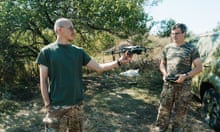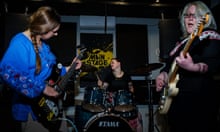We have all met a young man like Daniil Melnyk, this open-faced, sunny 21-year-old with a disarming grin. As soon as he walks into the studio, in a former factory in Lviv in western Ukraine, the chat and jokes begin. Melnyk is used to being here. He has been photographed several times by the artist Marta Syrko. But he’s less used to having an audience in the room. As soon as everyone has introduced themselves, he and Syrko get to work. First, he pulls off his sweatshirt and trousers, revealing the heavily tattooed body of a young soldier. Then he removes his prosthetic legs: he has had two below-the-knee amputations. He lacks three of the fingers of his right hand.
Syrko has asked him to position himself on a sheet of reflective metal. She surveys him from different angles, suggesting adjustments to his pose. At one point, she photographs him through a mirror – the resulting images will have a mysterious, slightly subaqueous feel. Julia Kochetova, the Observer photographer, darts around, capturing the whole process. Throughout, the conversation flows. Melnyk teases Syrko: “You’re like my teacher at school. But I can’t sit still!”
Syrko’s artistic focus has long been on the human body – “athletes’ bodies, older people’s bodies, thinking about the way the body holds experience”. She has worked with subjects with Down’s syndrome, and with her elderly grandparents, whom she has photographed nude: she makes portraits with a physical frankness that is unusual in socially conservative, religious western Ukraine. In November last year, she was in France for the annual Paris Photo art fair when she visited the Louvre and, as she wandered among the mutilated ancient Greek and Roman sculptures, a fresh project began to take shape in her mind. “The hardest thing,” she says, “was to find the first hero willing to be photographed – and then the next hardest thing was to explain that they were going to have to be naked, with their scars, with everything that had happened to them.”
Official figures put the number of Ukrainians who have undergone amputations at 20,000 since the start of the full-scale invasion, though experts on the ground suspect the real figure is much higher, perhaps as many as 50,000. The numbers are edging towards those of the first world war (historians estimate that 67,000 Germans and 41,000 Britons had amputations between 1914 and 1918). The scale of what is happening is obvious on the streets of Ukraine’s cities. And yet, Syrko noticed that this reality was not being reflected in the Ukrainian media.
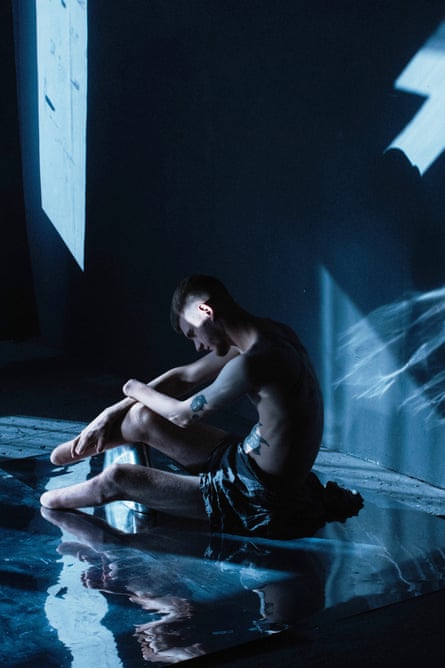
Syrko has now worked with several different people who have been seriously injured in the war, finding subjects by word of mouth or through Instagram or TikTok. Her first shoot, with a military volunteer who had lost both his legs, was not straightforward: it was in December last year, when Russia was targeting Ukrainian energy infrastructure and there were frequent blackouts. “It was cold and dark in the studio – we could only work for about 15 minutes,” she says. “And then afterwards we went for dinner and I realised how many difficulties disabled people have because of our lack of infrastructure. It was like a click in my head. I realised that I wanted to scream a bit about this issue. Now, almost two years from the start of the invasion, it is clear that we will soon have a totally different society. We have to get used to it. We have to understand how to act.”
And so, amid the battle to defend their country, Ukrainians face a second struggle: to adapt their society to this new reality. “Even if the war were to stop tomorrow, the number of amputations would keep climbing,” says Olga Rudnieva, chief executive of the charity Superhumans, which runs a rehabilitation centre in Lviv. “40% of Ukraine’s territory is now mined. It will take us decades to clear it, and people will be returning to their houses and they will be stepping on mines for years. And we haven’t even started the demining of forests and lakes. All this means that we have to be ready to work with people who have lost their limbs for years to come.”
Even today, there remains in Ukraine traces of a culture of stigma and denial that has deep roots in Soviet history. After the second world war, those with disabilities provided an uncomfortable reminder of the cost of the USSR’s victory. Disabled veterans were, in their thousands, deported to labour camps in Kazakhstan and the Valaam archipelago in Karelia. In the decades that followed, amputations following industrial accidents were commonplace but unacknowledged by the state. In 1980, Moscow hosted the Olympic, but not the Paralympic, games, after an official declared, “There are no disabled people in the Soviet Union.”
Melnyk heard about Syrko’s work through word of mouth and they began following each other on social media before she invited him to sit for her. His absolute determination to be open about what had happened to his body meant he had no qualms, only curiosity, about being photographed: their ease with each other in the studio is obvious.
Over coffee after the shoot, Melnyk talks about how he came to be injured – a story that pours straight out of him without a trace of self-pity or self-dramatisation. On 24 February 2022, the day the Russians began their full-scale invasion of Ukraine, he was two days away from graduating from military academy in Lviv. “It was very clear something was happening. The Russians were massing troops at the border,” he remembers. He was looking forward to an army career. He felt ready. He already knew what unit he wanted to serve in – and, as the tanks rolled into Ukraine, he went straight to join it, mailing his belongings to his family.
Within a week or so he was in Malyn, a town some 100km northwest of Kyiv, instructing mobilised civilians who had volunteered to help defend their country at this moment of extraordinary peril. “Some didn’t even know how to shoot – I taught them at least how a machine gun sounds, and not to drop it,” he said. Then he was chosen to be part of a squad that moved nearer to Kyiv, stationed in a former sanatorium. The Russians had been advancing south from Belarus, via Chornobyl, attempting to take Kyiv from the north and west. Around the commuter towns on the western fringes of the capital – Bucha, Irpin and Borodyanka – the fighting became intense and ferocious. On the night of 7 March, “we gathered an assault group, chose the guys, got the equipment. A convoy of nine vehicles left the sanatorium. We were moving down the highway between Bucha and Irpin. That’s when we were trapped and surrounded.”
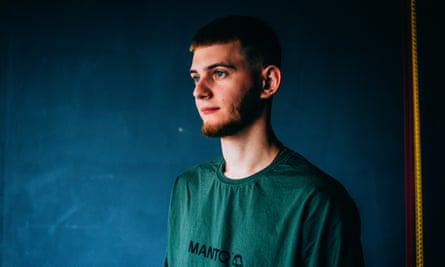
The convoy was stopped at a Russian checkpoint. After a brief standoff, the firing began – and the terror and confusion. “The guys from my squad – civilian volunteers, family men – were swearing. I was screaming at them to motivate them. A Russian tank shot at us. There were grenades.” The Ukrainian convoy was getting the worst of it. Melnyk was severely wounded. The men around him were dying. Vehicles were going up in flames. “I had shrapnel wounds in my feet and wrists. My helmet was destroyed. I understood that that’s it, basta, game over. Adrenaline did its work but there was a lot of blood. Everything was on fire. My vehicle and my guys were gone. I couldn’t shoot any more – I gave my ammo to a comrade.”
Melnyk used the last of his strength to crawl off the road through a fence, and into someone’s garden shed. And then, “while I was thinking what to do, the adrenaline wore off and I lost consciousness”.
He lay there, between life and death, in the sub-zero chill of Ukraine’s bleak winter, for two days. At one point he dragged himself towards a well in the yard and fainted, out there in the cold: he woke up to find a curious alsatian licking him, and managed to manoeuvre himself back under the meagre cover of the shed. He began hallucinating. “I thought I was in hospital surrounded by friends, asking for water,” he says.
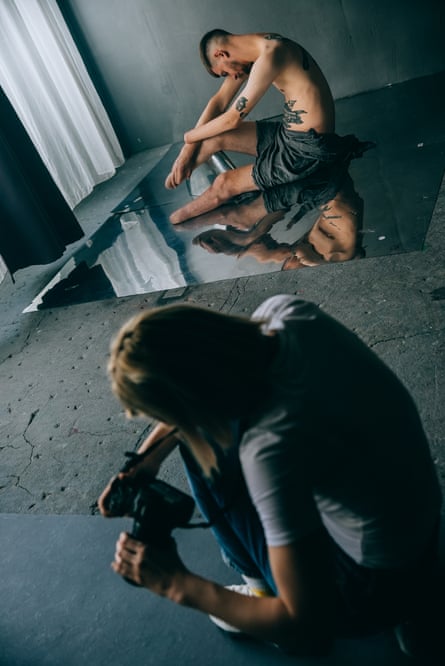
Eventually, Russian soldiers found him. He asked them to shoot him. When they refused, he asked them for water. When they refused this, too, he remembers asking: “What kind of people are you, if you won’t shoot me and you won’t give me water?” They took his equipment – flak jacket, ballistic goggles. Eventually, they did give him water and a mattress, but they left him to take his chances in the cold. “When I asked them why they had started the war, they said: ‘Because you are raping women and eating children.’”
The next day, he was told a car was coming that would take him to Belarus – if he survived that long, they said. By the evening, Melnyk was in very bad way: as well as having lost a lot of blood, he was feverish, and frostbitten. The Russians offered to give him a big shot of adrenaline: a quick and painless way out, they said.
Melnyk took the offer seriously. Knowing that a man about to die can usually scrounge a cigarette, he asked for one: a play for time. By the time the cigarette had burned down, he had decided to play his hand, meagre as it seemed. “I thought, ‘I’ve already been through so much: let’s just see how it goes.’”
After a shot of antibiotics, he was thrown into a vehicle and taken to a village where he was moved into a freezing school basement. His fellow captives were civilians: a wounded woman with mental disabilities and a man with alcoholism. “I was accused of being a Nazi. They threatened to kill me.” He was soon moved on to another village, into a school equipped as a hospital.
Russian medics removed some of the shrapnel from his wounds. “Again, they accused me of being a Nazi but I was grateful for the basic patching up,” he says. He was moved again: now to a field hospital in Belarus for more rough-and-ready care. That was a brief respite, though, before he was taken to yet another freezing basement in what could, he thinks, have been an industrial building. Here he was interrogated and beaten with a machine gun – “They were writing some kind of dossier” – and given very little to eat. After a couple of weeks he was transported to a prison somewhere in Russia where, he says, “I sometimes spent days without food. They were beating prisoners up.”
A military commander came to inspect him, and told him: “If the medics say you are unfit, they will take you into the treeline and shoot you.” Instead of that grim threat being carried out, he was taken to a military hospital. “The doctors would tell us ‘we’re going to cut off your balls’ or ‘we’re going to cut out your eyes’.” He was interrogated repeatedly. “Finally, I realised how to answer them. I understood that they just wanted some kind of answer to their questions. It didn’t really matter what. They treated us more or less OK, so I kept asking for more food and I refused to eat unless I could share it with the other guys.” In among the intimidation, the hunger and the brutal treatment, he occasionally encountered flashes of humanity, he says – medics who did their best, staff who discreetly brought him food.
There was a further move, to a hospital in Rylsk in Russia, where he remembers the nurses as hostile, telling him: “You’re killing our guys and we have to treat you.”
At this point, his wounded, frostbitten hands were starting to smell. “I spoke to the chief doctor, and told him I thought I was developing sepsis.” They amputated his left hand and three fingers of his right hand, and later also his toes. How on earth did he feel at this point? “I was fine,” he says, with remarkable equanimity. “I had had my chance to die, and I had made my choice.”
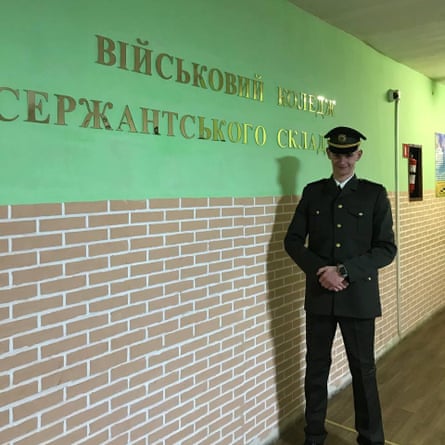
In April he was moved once more, this time to Kursk. Every day there were rumours of possible prisoner exchange. Finally, he and other Ukrainian soldiers were flown to the Crimea, and then driven to Zaporizhzhia region. From here he was finally able to call his mother, who up till that moment had no idea whether he was dead or alive. She fainted with the shock and relief, he tells me. Painfully thin and weak, he was released in a prisoner exchange on 21 April 2022.
Two days later, he had his below-the-knee amputations. When he was reunited with his family, he says, he found himself cheering them up – putting himself “in charge of family morale” as they absorbed the extent of his injuries. I can believe it: you feel that there is little that could dent this young man’s sunny temper and optimism.
He was also reunited with a mobile phone. “I was super happy to have social media again – and I made a decision that I wasn’t going to be ashamed of my situation, I was going to be absolutely open about it.” He also did something else. “I’d never seen prosthetics, I’d never seen people using them, I’d just heard the word. So I Googled it – and I saw images of people swimming, jumping, running. And I thought: ‘That will do.’”
It has been a long road for Melnyk. His first prostheses were fitted in Kyiv. Initially, he admits, he was in “constant discomfort”. It took time to rebuild his strength and his balance, and to get used to the artificial limbs. Later, thanks to the Minneapolis-based Protez Foundation, he was offered much better prosthetics: the medics there were shocked at what he had been managing with. While he was in the US, he was amazed to see mainstream supermarket advertisements featuring disabled models. “It blew my mind. I want this level of visibility for disabled people in Ukraine.” He had already started posting his progress to TikTok and Instagram: his first steps on his artificial legs, then more and more progress – jumping, dancing, kickboxing, driving.
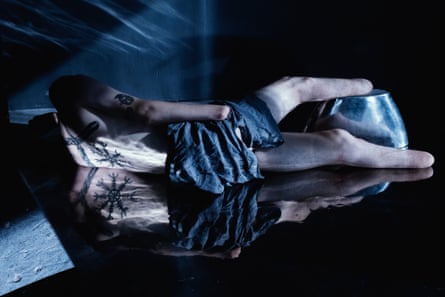
Working with Syrko is an important aspect of his activism, he says. “There has been enormous progress already but there needs to be radical change.” While he thinks about what might come next for him – he would like to train as a military psychologist – he has been articulating himself with increasing confidence. “Get used to it. Explain it to your children,” reads one post on Instagram. “Now, on the streets, more and more often, new beautiful people will appear… Their faces are disfigured and their bodies are scarred… Try not to point your fingers at them. Try not to look at them with pity.”
The challenge to remake Ukraine as a country in which disabled people lead lives of dignity is enormous. In order to accommodate its transformed society, it will have to institute vast infrastructural change: its urban fabric is, to put it mildly, ill-adapted to the needs of disabled people. The history of disabled-rights activism is bleak: in the 1980s, those who protested against the Soviet regime’s lack of provision were treated as dissidents and faced arrest or exile. The official attitude, says Rudnieva of Superhaumans, was: “We don’t have people without limbs. We are a ‘beautiful’ nation, a strong Soviet Union nation.” The prejudice has lingered. She still knows families who don’t take their disabled children out of the house during daylight hours. “It’ll take us years to change the culture.”
Nevertheless, there are signs that this is already happening, as those who have lost limbs since the full-scale invasion insist on visibility, many, like Melnyk, taking to social media to challenge perceptions. This autumn’s issue of Vogue Ukraine – the magazine is being published quarterly in spite of the war – features a shoot with amputees, ranging from army veterans, including Melnyk, to seven-year-old budding gymnast Oleksandra Paskal, who lost a leg in a Russian missile attack. As Rudnieva says, whatever happens next in the war, “we’re going to be a country of veterans – and we’re going to be a country of people with disabilities.”






